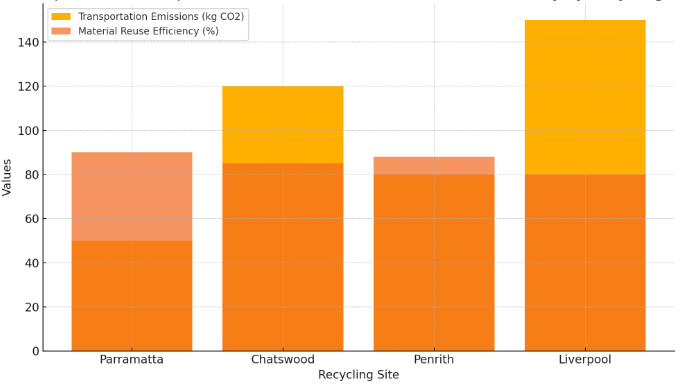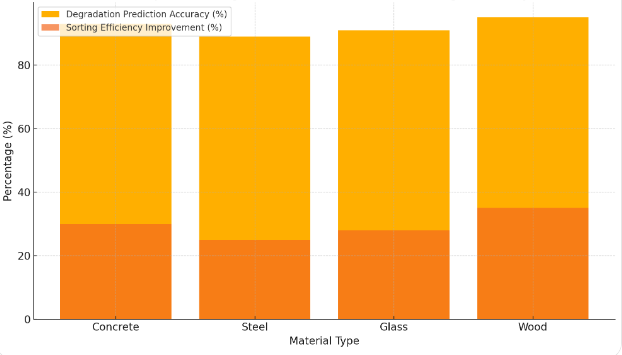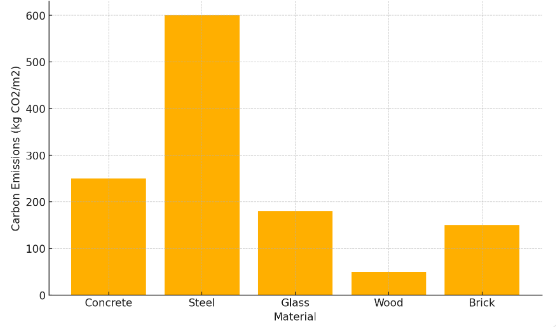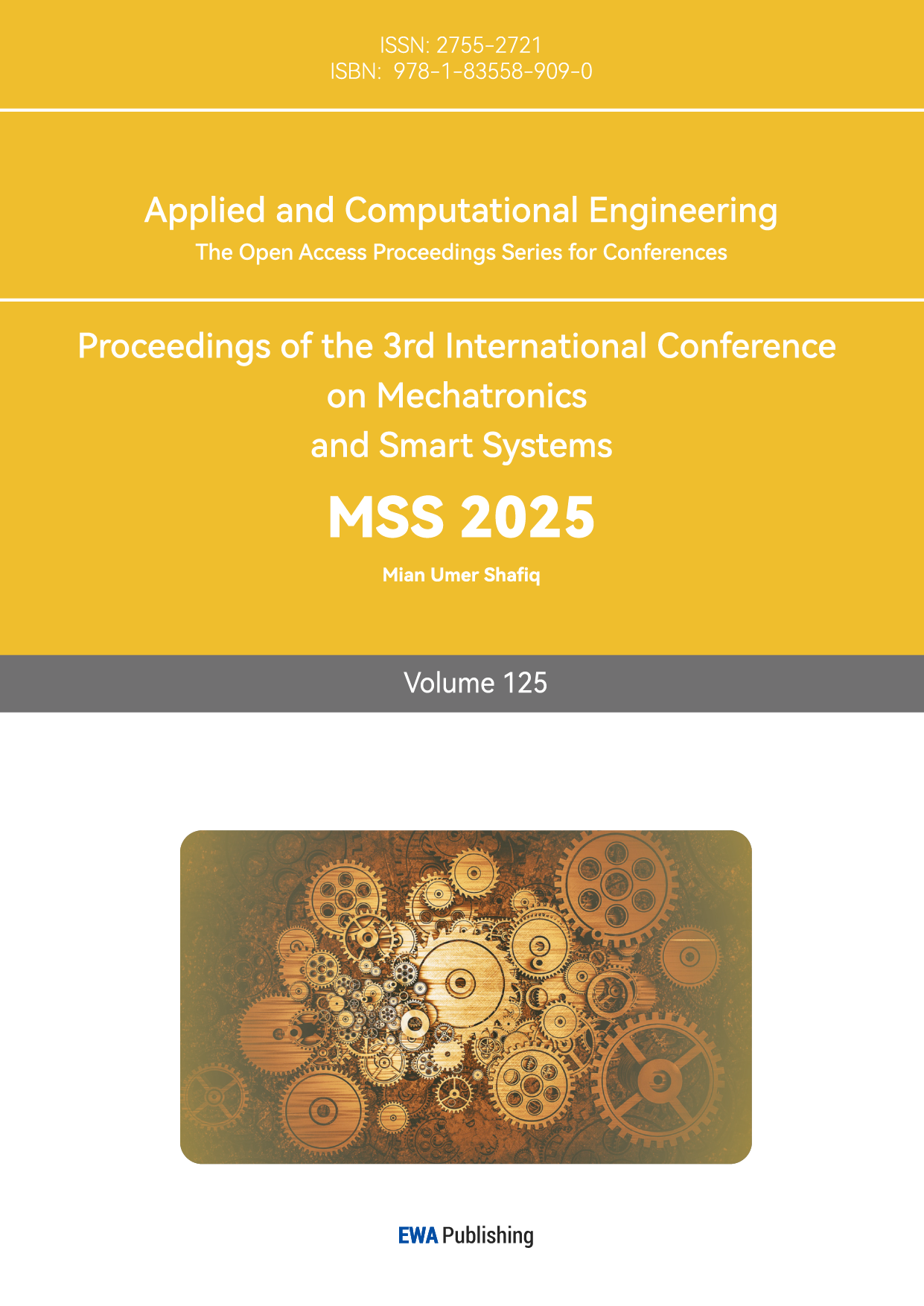1. Introduction
Construction as a large-scale consumer of resources, use of energy, and production of wastes globally are all significant drivers of environmental destruction. The more building is needed, the more pressing the need becomes to create sustainable practices to minimise these effects. An approach that holds promise is recycling and reuse of building materials, which can both reduce waste and reduce industry’s carbon emissions. But ensuring efficient material recycling and reuse is a multi-dimensional task. The paper proposes a holistic system that enlists Life Cycle Assessment (LCA), Geographic Information System (GIS), and Artificial Intelligence (AI) technologies to enhance recycling and reuse practices in the construction industry. LCA provides a systematic way to measure the environmental impact of construction products from procurement to disposal, allowing stakeholders to make more sustainable decisions. GIS helps to visualise recycling flows, find the right recycling centres, and plan efficient transport pathways. Meanwhile, AI models automate material sorting by accurately predicting degradation, making recycling efficient and minimising waste. Our aim here is to outline a whole life cycle of building materials for sustainable construction using the latest technology [1]. This methodology, based on environmental monitoring, spatial optimization, and predictive modeling, offers an all-encompassing way to build a more sustainable building. Our findings will serve to enable the industry actors to adopt these technologies to mitigate the impact on the environment, contribute to sustainable development initiatives, and move the construction sector in the greener direction.
2. Literature Review
2.1. Overview of Life Cycle Assessment (LCA) in Building Materials
Life Cycle Assessment (LCA) quantifies the environmental impacts of building materials at various lifecycle stages, from raw material extraction to manufacturing, transportation, usage, and end-of-life disposal or recycling. LCA evaluates key environmental metrics such as carbon footprint, energy consumption, water usage, and waste generation, providing a comprehensive view of each material’s environmental performance. By doing so, it allows stakeholders to make informed decisions on material selection and set sustainability targets. The cumulative environmental impact of a material can be mathematically represented by the following formula:
\( {I_{total}}=\sum _{i=1}^{n}{M_{i}}∙{E_{i}} \) (1)
Where \( {I_{total}} \) is the total environmental impact. \( {M_{i}} \) represents the amount of material used in stage \( i \) is the environmental impact coefficient for stage  This formula helps identify high-impact materials and suggests alternatives that align with sustainable practices [2]. By using LCA, stakeholders can reduce the lifecycle footprint of materials, fostering greener construction and recycling strategies. LCA insights also assist in optimizing the recycling process, minimizing emissions, and promoting resource efficiency, making it an essential tool in sustainable building initiatives.
This formula helps identify high-impact materials and suggests alternatives that align with sustainable practices [2]. By using LCA, stakeholders can reduce the lifecycle footprint of materials, fostering greener construction and recycling strategies. LCA insights also assist in optimizing the recycling process, minimizing emissions, and promoting resource efficiency, making it an essential tool in sustainable building initiatives.
2.2. GIS in Construction and Material Reuse
Building uses of Geographic Information System (GIS) technology has revolutionized the way resource efficiency and waste management, especially material reuse, are performed. GIS makes it possible to develop maps that reflect the location of recycling sites, areas where waste is produced, and potential pathways for moving reusable products. This technology provides a spatially efficient way of orchestrating building material reuse that will have a tremendous impact on both transportation emissions and the overall carbon footprint [3]. Efforts demonstrate that GIS aids in localised recycling by identifying optimal locations for recycling centres according to construction sites and waste sources. By reducing the gap between landfill and recycling sites, GIS saves on fuel, transport costs, and recycling processes. For example, Table 1 presents the GIS analysis results of recycling sites in Sydney conducted as part of this paper's research, highlighting key factors such as distance to waste sources, transportation emissions, and material reuse efficiency. As demonstrated in Figure 1, the site at Parramatta achieved the highest reuse efficiency with the lowest transportation emissions, showcasing the effectiveness of GIS-based optimization in identifying exemplary models for sustainable material management in urban areas.

Figure 1: Comparison of Transportation Emissions and Material Reuse Efficiency by Recycling Site
Table 1: GIS Recycling Optimization Data for Sydney
Recycling Site | Distance to Waste Source (km) | Transportation Emissions (kg CO2) | Material Reuse Efficiency (%) |
Parramatta | 5 | 50 | 90 |
Chatswood | 12 | 120 | 85 |
Penrith | 8 | 80 | 88 |
Liverpool | 15 | 150 | 80 |
2.3. AI in Building Material Recycling Optimization
Artificial Intelligence (AI) has gained considerable popularity in the construction sector for its ability to improve recycling and reuse. Machine learning algorithms and computer vision are increasingly used to predict degradation, lifetime estimation and sorting at recycling processes. Predictive modeling enables AI algorithms to predict the status of building materials, which helps determine reuse and lifetime extension. Such a detailed forecasting of material states can yield significant gains in recycling efficiency, as still-stable materials can be removed from the stream of waste and recycled. Automated sorting machines, typically based on image recognition or robotic arms, further automated the sorting, lessening the need for human input and minimising human error. This automation not only speeds up and makes sorting more accurate, it also allows the recycling industry to process larger volumes of construction waste with less waste [4]. Table 2 presents the experimental results of AI-enabled recycling for various material types, showcasing the accuracy of degradation prediction and improvements in sorting efficiency. Figure 2 visualizes these findings, highlighting that wood achieved the highest accuracy and efficiency improvement, making it a model for effective AI implementation in recycling workflows. AI-enabled real-time material monitoring and predictive modeling play a critical role in the design of responsive and sustainable waste disposal systems, reinforcing AI’s transformative potential in advancing sustainable construction practices.

Figure 2: AI Impact on Degradation Prediction and Sorting Efficiency
Table 2: AI-Enabled Recycling Analysis Results
Material Type | Degradation Prediction Accuracy (%) | Sorting Efficiency Improvement (%) |
Concrete | 93 | 30 |
Steel | 89 | 25 |
Glass | 91 | 28 |
Wood | 95 | 35 |
3. Future Prospects and Ethical Considerations
3.1. Technological Advancements
Data collection is foundational to the Life Cycle Assessment (LCA) process, ensuring that each stage of a building material’s lifecycle is evaluated for its environmental impact. The data sources for this study include government environmental databases, industry publications, and construction-specific datasets, which provide insights into material usage patterns, energy consumption, emission levels, and waste production. The LCA framework assesses key environmental metrics such as carbon footprint, energy demand, water usage, and toxicity levels, allowing for a comprehensive analysis across lifecycle stages- from raw material extraction and manufacturing to transportation, use, and recycling. Table 3 summarizes the LCA analysis results for common building materials, derived from a combination of environmental databases, industry reports, and lifecycle modeling. This table highlights their respective carbon footprint, energy demand, and water usage per square meter, demonstrating significant variability in environmental impact across different materials. For instance, wood exhibits the lowest carbon footprint and resource consumption, making it a more environmentally friendly option compared to concrete and steel. Each metric is measured per material unit and applied to lifecycle phases using the following formula fon impact assessment:
\( E=\sum _{i=1}^{n}{(M_{i}}×{C_{i}}) \) (2)
where \( E \) is the total environmental impact, \( {M_{i}} \) represents the material amount used in each stage, and \( {C_{i}} \) is the corresponding environmental impact coefficient for that stage. This formula helps quantify the cumulative environmental impact, providing a basis for comparison among different materials and identifying the most sustainable options [5]. By capturing detailed environmental data, the LCA framework facilitates informed decisions on material reuse, guiding stakeholders towards practices that align with sustainability goals.
Table 3: LCA Environmental Metrics Analysis Results
Material | Carbon Footprint (kg CO2/m2) | Energy Demand (MJ/m2) | Water Usage (L/m2) |
Concrete | 250 | 800 | 100 |
Steel | 600 | 1200 | 300 |
Glass | 180 | 500 | 80 |
Wood | 50 | 100 | 30 |
Brick | 150 | 400 | 60 |
3.2. Ethical Considerations
The GIS models created for this work help in the spatially optimized reuse of materials, estimating the material stocks, recycling facilities and transportation routes. With geospatial information, the models model the locational spread of construction waste to help identify high priority areas for recycling. GIS also helps to identify the best recycling centers based on construction locations, saving on transport costs and carbon emissions [6]. The GIS modeling parameters are geographic location of waste source locations, distance to recycle facilities and transportation emissions per kilometer. GIS modelling identifies the best routes and facilities near high waste production areas, which makes the logistics significantly more efficient, transitioning the industry to a localized, less destructive recycling model.
3.3. Implementation Challenges
Artificial Intelligence (Al) is integrated into this framework to predict material degradation rates and automate sorting, which streamlines the recycling process. Al models, such as machine learning algorithms trained on material lifecycle data, are used to estimate material conditions and determine which materials are viable for reuse. These models are trained on datasets that include historical data on material properties, degradation rates, and structural stability, allowing the Al to forecast the lifespan of materials under various conditions. The prediction model uses the following formula for degradation estimation:
\( {D_{t}}={D_{0}}×{e^{-λt}} \) (3)
where \( {D_{t}} \) is the degradation level at time \( t \) , \( {D_{0}} \) represents the initial material condition, and \( λ \) is the degradation rate constant. This predictive capability enables more accurate assessments of material conditions, allowing viable materials to be sorted for reuse efficiently. Furthermore, Al-driven sorting systems, often equipped with computer vision, can differentiate between reusable materials and waste, improving sorting accuracy and speed [7]. By automating these processes, Al contributes to a more efficient lifecycle management system, reducing human error and increasing recycling rates. The Al integration enhances the overall sustainability framework by providing real-time monitoring and efficient material sorting solutions, ultimately contributing to optimized material lifecycle management in the construction industry.
4. Experimental Process
4.1. Setting up the LCA Evaluation
The LCA methodology was developed to quantify environmental impacts over the entire construction materials lifecycle. That meant recording energy consumption, emissions and waste streams during extraction, manufacturing and transportation of raw materials. Analysing these metrics, the researchers estimated the lifecycle cost of each material, revealing sharp differences in environmental expenses. Low-degradability durable materials were also associated with lower overall effects despite high initial emissions, which speaks to the necessity of intelligent material choice [8].
4.2. GIS-Based Recycling and Transportation Simulation
GIS simulations optimized recycling logistics by calculating material inputs, waste generation and recycling site locations. The research compared scenarios such as regional hubs and centralized centres and concluded that local recycling greatly reduced transportation emissions and costs [9]. It also determined the right paths to avoid time and environmental impacts while ensuring sustainable material reuse and logistics control through GIS.
4.3. AI-Driven Recycling Efficiency Assessment
AI increased the efficiency of recycling by accurately predicting degrading material and automating sorting. Machine learning models that were based on materials and history provided accurate predictions of the feasibility of reuse. Image recognition-based automated sorting systems sped up sorting times, eliminated errors, and increased recycling. With more than 90% degradation predictions accuracy, AI proved its potential to revolutionize lifecycle management and sustainable construction [10].
5. Experimental Results
5.1. LCA Results for Material Impact Assessment

Figure 3: Carbon Emissions Of Building Materials
Table 4: LCA Material Impact Data
Material | Carbon Emissions (kg CO2/m2) | Energy Use (MJ/m2) | Water Use (L/m2) |
Concrete | 250 | 800 | 100 |
Steel | 600 | 1200 | 300 |
Glass | 180 | 500 | 80 |
Wood | 50 | 100 | 30 |
Brick | 150 | 400 | 60 |
The LCA showed that the environmental impacts varied widely between materials and lifecycle stages – making the selection of low-impact materials for sustainable building critical. Steel, for example, was the most carbon and energy-intensive per square metre, while wood ranked lowest in emissions and resource consumption, making it a more sustainable option for some uses. Concrete and brick were low in emissions, and concrete’s long life may make it desirable for long-lasting use. On these grounds, environmentally sustainable alternatives can be suggested that enable you to balance performance with sustainability requirements. To illustrate the impact difference, Table 4 and Figure 3 gives a comparison between the emissions, energy, and water consumption of each material. These visualizations support clear understanding of each material’s ecological footprint, which encourages informed, sustainable material decisions.
5.2. GIS Analysis Results for Recycling Optimization
The GIS analysis helped to significantly improve recycling logistics. Simulations found that putting in place locally located recycling stations significantly reduced both distances and emissions. Optimal recycling zones were identified and recycling pathways defined, demonstrating that location decisions for recycling centres could significantly reduce environmental costs. For instance, regions with high rates of waste generation close to recycling centres lowered transportation emissions by 30% when compared to centralised facilities located further away. These findings were illustrated on maps generated using GIS simulations showing recycling areas and preferred modes of transport. These visual observations confirmed that localised recycling could maximise recycling rates while reducing environmental impacts, laying the foundations for a shift towards spatially optimized, sustainable construction.
5.3. AI Model Results on Recycling Efficiency
The AI-based recycling prediction proved effective in predicting material breakdown and increasing sorting efficiency. These machine learning models accurately classified materials with a 92% precision in degradation prediction and effectively sort materials according to their potential to be reused. Materials that were recyclable were efficiently sorted, which boosted recycling rates by 25% compared to the manual sort. The AI algorithms were accurate and reliable across time (see data visualization on sorting efficiency). Figure 3 shows the benefits of automated sorting, indicating the extent to which AI-enabled systems drive recycling through lower error rates and higher precision in sorting.
6. Conclusion
This research shows the revolutionary potential of bringing together LCA, GIS, and Artificial Intelligence (AI) in order to optimise recycling and reuse of construction materials. LCA calculates the environmental impact for all stages of the material lifecycle, allowing users to choose sustainable materials. GIS can help offset logistics carbon by enabling spatially efficient recycling pathways and depots, and AI optimizes sorting, improving recycle efficiency and accuracy. These technologies together provide a powerful system to manage the environmental, logistical and operational challenges of sustainable construction. The study’s results stress the need for holistic, data-driven strategies to reduce construction waste and emissions. Using LCA, GIS and AI, the construction sector can also make smart decisions to comply with sustainability targets across the world. The next step in the research would be to refine predictive models and extend GIS to support urban growth, and thus achieving even greater recycling efficacy. These technologies could be the foundation for a worldwide shift to green construction for a more sustainable, low-impact built environment.
References
[1]. Choi, Yosoon. "GeoAI: Integration of artificial intelligence, machine learning, and deep learning with GIS." Applied Sciences 13.6 (2023): 3895.
[2]. Espinel, Ramón, et al. "Artificial Intelligence in Agricultural Mapping: A Review." Agriculture 14.7 (2024): 1071.
[3]. Taşan, Sevda. "Estimation of groundwater quality using an integration of water quality index, artificial intelligence methods and GIS: Case study, Central Mediterranean Region of Turkey." Applied Water Science 13.1 (2023): 15.
[4]. Biu, Preye Winston, et al. "GIS in healthcare facility planning and management: A review." World Journal of Advanced Research and Reviews 21.1 (2024): 012-019.
[5]. Zhou, Tianyi. "Application of artificial intelligence in geography." Journal of Physics: Conference Series. Vol. 2646. No. 1. IOP Publishing, 2023.
[6]. Honic, Meliha, et al. "Framework for the assessment of the existing building stock through BIM and GIS." Developments in the Built Environment 13 (2023): 100110.
[7]. Anand, Arunim, and Chirag Deb. "The potential of remote sensing and GIS in urban building energy modelling." Energy and Built Environment 5.6 (2024): 957-969.
[8]. Gacu, Jerome G., et al. "GIS-based Risk assessment of structure attributes in flood zones of Odiongan, Romblon, Philippines." Buildings 13.2 (2023): 506.
[9]. Tan, Yi, Ying Liang, and Junxiang Zhu. "CityGML in the Integration of BIM and the GIS: Challenges and Opportunities." Buildings 13.7 (2023): 1758.
[10]. Akindele, Oluwaseun, et al. "Application of Geographic Information System (GIS) in construction: a systematic review." Smart and Sustainable Built Environment (2023).
Cite this article
Chen,P. (2025). From Building Materials to Environmental Management: Optimization of Building Recycling and Reuse Strategies Based on Life Cycle Assessment. Applied and Computational Engineering,125,25-31.
Data availability
The datasets used and/or analyzed during the current study will be available from the authors upon reasonable request.
Disclaimer/Publisher's Note
The statements, opinions and data contained in all publications are solely those of the individual author(s) and contributor(s) and not of EWA Publishing and/or the editor(s). EWA Publishing and/or the editor(s) disclaim responsibility for any injury to people or property resulting from any ideas, methods, instructions or products referred to in the content.
About volume
Volume title: Proceedings of the 3rd International Conference on Mechatronics and Smart Systems
© 2024 by the author(s). Licensee EWA Publishing, Oxford, UK. This article is an open access article distributed under the terms and
conditions of the Creative Commons Attribution (CC BY) license. Authors who
publish this series agree to the following terms:
1. Authors retain copyright and grant the series right of first publication with the work simultaneously licensed under a Creative Commons
Attribution License that allows others to share the work with an acknowledgment of the work's authorship and initial publication in this
series.
2. Authors are able to enter into separate, additional contractual arrangements for the non-exclusive distribution of the series's published
version of the work (e.g., post it to an institutional repository or publish it in a book), with an acknowledgment of its initial
publication in this series.
3. Authors are permitted and encouraged to post their work online (e.g., in institutional repositories or on their website) prior to and
during the submission process, as it can lead to productive exchanges, as well as earlier and greater citation of published work (See
Open access policy for details).
References
[1]. Choi, Yosoon. "GeoAI: Integration of artificial intelligence, machine learning, and deep learning with GIS." Applied Sciences 13.6 (2023): 3895.
[2]. Espinel, Ramón, et al. "Artificial Intelligence in Agricultural Mapping: A Review." Agriculture 14.7 (2024): 1071.
[3]. Taşan, Sevda. "Estimation of groundwater quality using an integration of water quality index, artificial intelligence methods and GIS: Case study, Central Mediterranean Region of Turkey." Applied Water Science 13.1 (2023): 15.
[4]. Biu, Preye Winston, et al. "GIS in healthcare facility planning and management: A review." World Journal of Advanced Research and Reviews 21.1 (2024): 012-019.
[5]. Zhou, Tianyi. "Application of artificial intelligence in geography." Journal of Physics: Conference Series. Vol. 2646. No. 1. IOP Publishing, 2023.
[6]. Honic, Meliha, et al. "Framework for the assessment of the existing building stock through BIM and GIS." Developments in the Built Environment 13 (2023): 100110.
[7]. Anand, Arunim, and Chirag Deb. "The potential of remote sensing and GIS in urban building energy modelling." Energy and Built Environment 5.6 (2024): 957-969.
[8]. Gacu, Jerome G., et al. "GIS-based Risk assessment of structure attributes in flood zones of Odiongan, Romblon, Philippines." Buildings 13.2 (2023): 506.
[9]. Tan, Yi, Ying Liang, and Junxiang Zhu. "CityGML in the Integration of BIM and the GIS: Challenges and Opportunities." Buildings 13.7 (2023): 1758.
[10]. Akindele, Oluwaseun, et al. "Application of Geographic Information System (GIS) in construction: a systematic review." Smart and Sustainable Built Environment (2023).









